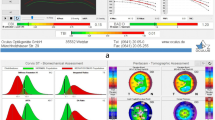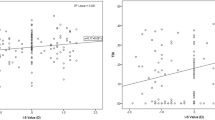Abstract
Purpose
To evaluate corneal biomechanical changes using Corvis ST in patients treated with photorefractive keratectomy (PRK) 25 years ago.
Methods
In this study, 32 post-PRK and 38 normal eyes underwent Corvis ST (CST) assessments. The measured CST factors were: time of highest concavity (HC), time of applanation 1 (AT1), time of applanation 2 (AT2), length of applanation 1 (AL1), length of applanation 2 (AL2), velocity of applanation 1 (AV1), velocity of applanation 2 (AV2), deformation amplitude (DA), peak distance (PD), integrated radius (IR), Ambrosio relational thickness horizontal (ARTh), stiffness parameter at first applanation (SP-A1), DA ratio (2 mm), Belin/Ambrosio enhanced ectasia display (BAD) and corneal biomechanical index (CBI).
Results
The mean [± standard deviation (SD)] age was 51.4 ± 7.36 years in PRK, 51.4 ± 3.62 in control group. PRK was performed 24.69 ± 1.78 years ago. ARTh, SP-A1, AT1, AL1, and AL2 were lower in PRK. PD, AT2, DA ratio (2 mm), and IR were statistically higher in PRK (P < 0.01). In PRK and control group the mean value of CBI was 0.91 ± 0.11 and 0.50 ± 0.27 (P < 0.001), and mean value of BAD was 3.34 ± 1.53 and 1.1 ± 0.70 (P < 0.001). In PRK 71.9% of eyes were classed “high risk CBI plus diseased BAD” and 25% remained in the “high risk CBI and normal BAD” group.
Conclusions
In this study, most of the post-PRK eyes which were clinically and topographically normal were classified as “high risk CBI plus diseased BAD” and had significantly worse CBI and BAD values than the control group. This leads to the conclusion that CBI and BAD alone are not appropriate to evaluate post-PRK ectasia.
Similar content being viewed by others
References
Taneri S, Weisberg M, Azar DT (2011) Surface ablation techniques. J Cataract Refract Surg 37(2):392–408. https://doi.org/10.1016/j.jcrs.2010.11.013
Ang EK, Couper T, Dirani M, Vajpayee RB, Baird PN (2009) Outcomes of laser refractive surgery for myopia. J Cataract Refract Surg 35(5):921–933. https://doi.org/10.1016/j.jcrs.2009.02.013
Guirao A (2005) Theoretical elastic response of the cornea to refractive surgery: risk factors for keratectasia. J Refract Surg 21(2):176–185
Roberts C (2005) Biomechanical customization: the next generation of laser refractive surgery. J Cataract Refract Surg 31(1):2–5. https://doi.org/10.1016/j.jcrs.2004.11.032
Klein SR, Epstein RJ, Randleman JB, Stulting RD (2006) Corneal ectasia after laser in situ keratomileusis in patients without apparent preoperative risk factors. Cornea 25(4):388–403. https://doi.org/10.1097/01.ico.0000222479.68242.77
Lanza M, Iaccarino S, Bifani M (2016) In vivo human corneal deformation analysis with a Scheimpflug camera, a critical review. J Biophotonics 9(5):464–477. https://doi.org/10.1002/jbio.201500233
Lanza M, Cennamo M, Iaccarino S, Romano V, Bifani M, Irregolare C, Lanza A (2015) Evaluation of corneal deformation analyzed with a Scheimpflug based device. Cont Lens Anterior Eye 38(2):89–93. https://doi.org/10.1016/j.clae.2014.10.002
Chen X, Stojanovic A, Hua Y, Eidet JR, Hu D, Wang J, Utheim TP (2014) Reliability of corneal dynamic scheimpflug analyser measurements in virgin and post-PRK eyes. PLoS ONE 9(10):e109577. https://doi.org/10.1371/journal.pone.0109577
Vinciguerra R, Ambrósio R Jr, Elsheikh A, Roberts CJ, Lopes B, Morenghi E, Azzolini C, Vinciguerra P (2016) Detection of Keratoconus With a New Biomechanical Index. J Refract Surg 32(12):803–810. https://doi.org/10.3928/1081597X-20160629-01
Belin MW, Villavicencio OF, Ambrósio RR Jr (2014) Tomographic parameters for the detection of keratoconus: suggestions for screening and treatment parameters. Eye Contact Lens 40(6):326–330. https://doi.org/10.1097/ICL.0000000000000077
Poyales F, Garzón N, Mendicute J, Illarramendi I, Caro P, Jáñez O, Argüeso F, López A (2017) Corneal densitometry after photorefractive keratectomy, laser-assisted in situ keratomileusis, and small-incision lenticule extraction. Eye (Lond) 31(12):1647–1654. https://doi.org/10.1038/eye.2017.107
Yang K, Xu L, Fan Q, Gu Y, Song P, Zhang B, Zhao D, Pang C, Ren S (2020) Evaluation of new Corvis ST parameters in normal, Post-LASIK, Post-LASIK keratectasia and keratoconus eyes. Sci Rep 10(1):5676. https://doi.org/10.1038/s41598-020+-62825-y
Shen Y, Chen Z, Knorz MC, Li M, Zhao J, Zhou X (2014) Comparison of corneal deformation parameters after SMILE, LASEK, and femtosecond laser-assisted LASIK. J Refract Surg 30(5):310–318. https://doi.org/10.3928/1081597x-20140422-01
Yu AY, Shao H, Pan A, Wang Q, Huang Z, Song B, McAlinden C, Huang J, Chen S (2020) Corneal biomechanical properties in myopic eyes evaluated via Scheimpflug imaging. BMC Ophthalmol 20(1):279. https://doi.org/10.1186/s12886-020-01530-w
Hashemi H, Asgari S, Mortazavi M, Ghaffari R (2017) Evaluation of corneal biomechanics after excimer laser corneal refractive surgery in high myopic patients using dynamic scheimpflug technology. Eye Contact Lens 43(6):371–377. https://doi.org/10.1097/ICL.0000000000000280
Lanza M, De Rosa L, Sbordone S, Boccia R, Gironi Carnevale UA, Simonelli F (2020) Analysis of corneal distortion after myopic PRK. J Clin Med 10(1):82. https://doi.org/10.3390/jcm10010082
Lanza M, Cennamo M, Iaccarino S, Irregolare C, Rechichi M, Bifani M, Gironi Carnevale UA (2014) Evaluation of corneal deformation analyzed with Scheimpflug based device in healthy eyes and diseased ones. Biomed Res Int 2014:748671. https://doi.org/10.1155/2014/748671
Salomão MQ, Hofling-Lima AL, Gomes Esporcatte LP, Lopes B, Vinciguerra R, Vinciguerra P, Bühren J, Sena N Jr, Luz Hilgert GS, Ambrósio R Jr (2020) The role of corneal biomechanics for the evaluation of ectasia patients. Int J Environ Health Res 17(6):2113. https://doi.org/10.3390/ijerph17062113
Funding
The authors declare that no funds, Grants, or other support were received during the preparation of this manuscript.
Author information
Authors and Affiliations
Contributions
All authors contributed to the study conception and design. Material preparation, data collection and analysis were performed by SÖ, GG and KB. The first draft of the manuscript was written by SÖ and all authors commented on previous versions of the manuscript. All authors read and approved the final manuscript.
Corresponding author
Ethics declarations
Conflict of interest
The authors have no relevant financial or non-financial interests to disclose.
Ethical approval
This study was performed in line with the principles of the Declaration of Helsinki. Approval was granted by the Ethics Committee of Health Science University, Dr. Abdurrahman Yurtarslan Oncology Training Hospital, Department of Ophthalmology (Date: 08.01.2020; File number: 2020-01/497).
Consent to participate
Informed consent was obtained from all individual participants included in the study.
Additional information
Publisher's Note
Springer Nature remains neutral with regard to jurisdictional claims in published maps and institutional affiliations.
Rights and permissions
Springer Nature or its licensor holds exclusive rights to this article under a publishing agreement with the author(s) or other rightsholder(s); author self-archiving of the accepted manuscript version of this article is solely governed by the terms of such publishing agreement and applicable law.
About this article
Cite this article
Özdoğan, S., Gürelik, G. & Bilgihan, K. Analysis of corneal biomechanical properties 25 years after myopic photorefractive keratectomy. Int Ophthalmol 43, 325–331 (2023). https://doi.org/10.1007/s10792-022-02436-w
Received:
Accepted:
Published:
Issue Date:
DOI: https://doi.org/10.1007/s10792-022-02436-w




